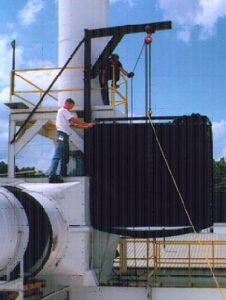In modern industrial operations, wet scrubbers play a critical role in mitigating airborne pollutants, particularly in processes that generate corrosive vapors, acid mists, and hazardous particulates. From fertilizer manufacturing to metal finishing, the demand for reliable, long-lasting industrial scrubbers continues to grow as environmental regulations tighten and process complexity increases.
Kimre’s engineering philosophy centers on performance-driven design. Our expertise in industrial wet scrubber systems, mist eliminators, and air pollution control technologies allows us to deliver tailored solutions that optimize contaminant capture while maintaining operational integrity—even in the most chemically aggressive environments.
The Importance of Material Selection in Industrial Wet Scrubbers
The selection of construction materials is fundamental to the long-term performance and reliability of any industrial wet scrubber. Each process gas stream presents a unique set of chemical, thermal, and mechanical challenges. As such, the choice of material must align with the specific conditions of operation, including temperature profiles, gas composition, particulate loading, and required removal efficiencies.
Common Material Options for Wet Scrubber Construction:
- Stainless Steel (304/316 and higher alloys)
Widely used in high-temperature or oxidizing environments, stainless steel provides excellent structural strength and resistance to acid gas corrosion. It is frequently deployed in scrubbers for sulfuric acid production, metal refining, and high-temperature gas streams. - FRP (Fiberglass-Reinforced Plastic)
FRP is the material of choice for many chemical scrubber systems, particularly in fertilizer and phosphoric acid production. It offers excellent corrosion resistance at moderate temperatures and is considerably lighter than metal alternatives, making it suitable for large vertical towers. - Thermoplastics (PVC, CPVC, Polypropylene)
For lower temperature applications, thermoplastics offer a cost-effective and corrosion-resistant solution. They are ideal for industrial wet scrubbers treating mildly corrosive vapors or condensable organics in compact systems. - Specialty Alloys (Hastelloy, Titanium)
In environments with extreme chemical aggressiveness—such as those involving halogenated compounds or hot acid vapors—specialty alloys may be required to ensure material integrity and extended service life.
The engineering team at Kimre evaluates not only chemical compatibility but also fabrication feasibility, weight considerations, maintenance access, and expected mechanical loads when designing custom industrial scrubbers for each application.
Why Material Selection Impacts Total Cost of Ownership
Choosing the correct material goes beyond corrosion resistance. It influences:
- Maintenance cycles
- System longevity
- Downtime frequency
- Safety risk from unexpected failure
- Operational cost-efficiency
An incorrectly specified material—even one with high corrosion resistance—can result in premature failure if thermal expansion, erosion, or solvent stress cracking are not considered. Kimre’s design approach integrates comprehensive process analysis and decades of field experience to specify the optimal material for each system component, from vessel walls to internals and demisters.
The Value of Partnering with Proven Industrial Scrubber Manufacturers
Effective process gas treatment demands more than off-the-shelf equipment. It requires a deep understanding of fluid dynamics, gas-liquid interaction, and long-term material performance. As one of the most experienced industrial scrubber manufacturers in North America, Kimre delivers more than components—we provide complete wet scrubbing systems engineered to exacting standards.
Whether treating acid gases in fertilizer production, managing chromic acid mists in plating operations, or removing volatile organic compounds (VOCs) from asphalt processing, our team tailors solutions that meet emission targets while minimizing operational complexity.
Our systems routinely integrate:
- Custom-engineered mist eliminators
- Corrosion-resistant internals and structural components
- High-performance packing materials
- Precision liquid distribution systems
The Operational Benefits of Industrial Wet Scrubbers
Across sectors, industrial wet scrubbers provide essential protection for both environmental and operational systems. Key benefits include:
- Regulatory Compliance
Achieve and maintain compliance with EPA, EU, and other international emission standards. - Asset Protection
Scrubbers act as first-line defense against acid and solvent gases that corrode ducting, fans, and heat exchangers. - Occupational Safety
Removing airborne contaminants ensures a safer, healthier work environment for plant personnel. - Sustainability and ESG Alignment
Lowering hazardous emissions supports corporate environmental goals and strengthens public trust.
Kimre’s advanced air pollution control systems are installed across a range of industries, including phosphate fertilizer, sulfuric acid, steel pickling, chlor-alkali, and nitric acid plants—each requiring nuanced scrubbing solutions designed to meet highly specific process parameters.
Also Read :
What is the Function of Wet Scrubbers in Industrial Processes?
How Mist Eliminator Design Directly Impacts Wet Scrubber Performance
Kimre’s Role in Delivering Long-Term Scrubber Performance
With more than four decades of specialized experience, Kimre has become a trusted name in the field of industrial emissions control systems. All systems are manufactured in the United States and undergo rigorous quality assurance processes. Our portfolio includes:
- Wet scrubbers (venturi, packed bed, and combination units)
- Fiber bed and mesh pad mist eliminators
- Tower internals and high-efficiency packing
- Drift eliminators and liquid coalescers
Every system we engineer is backed by thorough process data evaluation, CFD modeling as needed, and onsite technical consultation. This ensures our clients receive scrubbers that are both high-performing and operationally resilient.
The Next Step Toward Reliable Emissions Control
Material selection is not a secondary concern—it is central to scrubber effectiveness and lifecycle value. At Kimre, we help our clients navigate this complexity with confidence, delivering custom-engineered wet scrubbers that withstand the realities of industrial duty.
Whether you're planning a new installation or upgrading legacy equipment, our team is prepared to engineer a solution that meets both current regulatory demands and future performance expectations.
Contact Kimre today to discuss how our material expertise and emissions control technologies can support your clean air goals.


